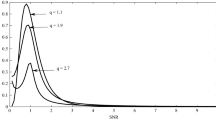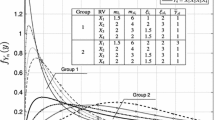Abstract
Nakagami-m distribution is utilized heavily in modelling multipath interferences in wireless networks. However, the closed form of the quantile function of the distribution is not available. The unavailability of the closed form is a result of the intractable nature of the cumulative distribution function (CDF). Hence, the inversion method cannot be used to recover the quantile function (QF) from the CDF of Nakagami-m distribution. Approximation is often the only choice available and numerical optimization method is one of the new forms of quantile approximation. This work proposed a new quantile model which is used to fit the machine values of QF of some selected parameters of the distribution. Differential evolution was used to minimize the error that resulted from the curve fitting. The resulting model is an appreciably improvement over some existing ones found in literature, using the root mean square error as the performance metric. In addition, the precision of the model increases as the shape parameter of the distribution decreases and the model was able to capture the extreme tails of the distribution better than the other previous published results. Thereafter, the usefulness of the model was seen in random number generation and Monte Carlo simulation. Anderson–Darling test showed that the simulated random variables are not from the normal distribution, despite the huge sample size. Different aspects of wireless communications will benefit from the applications of this work.






























Similar content being viewed by others
References
Parzen, E. (2004). Quantile probability and statistical data modeling. Statistical Science, 19(4), 652–662.
Gilchrist, W. G. (2007). Modeling and fitting quantile distributions and regressions. American Journal of Mathematical and Management Sciences, 27(3–4), 401–439.
Kong, L., & Mizera, I. (2012). Quantile tomography: Using quantiles with multivariate data. Statistica Sinica, 22(4), 1589–1610.
Koza, J. R. (1992). Genetic programming: On the programming of computers by means of natural evolution. Cambridge: MIT Press.
Onwubolu, G. C., & Babu, B. V. (2014). New optimization techniques in engineering. Berlin: Springer. ISBN 978-3-540-20167-0.
Fogel, D. B. (1995). Evolutionary computation: Toward a new philosophy of machine intelligence. Piscataway, NJ: IEEE Press.
Okagbue, H. I., Adamu, M. O., & Anake, T. A. (2018). Ordinary differential equations of probability functions of convoluted distributions. International Journal of Advanced and Applied Sciences, 5(10), 46–52.
Okagbue, H. I., Adamu, M. O., & Anake, T. A. (2019). Quantile mechanics: Issues arising from critical review. International Journal of Advanced and Applied Sciences, 6(1), 9–23. https://doi.org/10.21833/ijaas.2019.01.002.
Okagbue, H. I., Adamu, M. O., & Anake, T. A. (2018). Closed form expressions for the quantile function of the Erlang distribution used in engineering models. Wireless Personal Communications, 104(4), 1393–1408. https://doi.org/10.1007/s11277-018-6090-x.
Nair, N. U., & Sankaran, P. G. (2009). Quantile based reliability analysis. Communications in Statistics Theory and Methods, 38, 222–232.
Diaz Ochoa, J. G. (2018). Elastic multi-scale mechanisms: Computation and biological evolution. Journal of Molecular Evolution, 86(1), 47–57.
Queiroz, W. J. L., Almeida, D. B. T., Madeiro, F., Cardoso, J. V. M., Pereira, D. F. L., & Alencar, M. S. (2018). New closed-form expressions for SNR estimates of Nakagami fading channels by the method of moments. Telecommunication Systems, 69(3), 321–333.
Hasan, M. I., & Kumar, S. (2017). Spectral efficiency of dual diversity selection combining schemes under correlated Nakagami-0.5 fading with unequal average received SNR. Telecommunication Systems, 64(1), 3–16.
Tuan, V. P., & Kong, H. Y. (2018). Exploiting cooperative relays to enhance the performance of energy-harvesting systems over Nakagami-m fading channels. Telecommunication Systems, 69(4), 477–487.
Nguyen-Huu, P., & Ho-Van, K. (2018). Bidirectional relaying with energy harvesting capable relay: outage analysis for Nakagami-m fading. Telecommunication Systems, 69(3), 335–347.
Queiroz, W. J. L., Madeiro, F., Lopes, W. T. A., & Alencar, M. S. (2018). On the performance of M-QAM for Nakagami channels subject to gated noise. Telecommunication Systems, 68(1), 1–10.
Badarneh, O. S., Almehmadi, F. S., & Aldalgamouni, T. (2018). On the application of the sum of generalized Gaussian random variables: Maximal ratio combining. Telecommunication Systems, 67(3), 415–422.
Ben Halima, N., & Boujemâa, H. (2019). Round robin, distributed and centralized relay selection for cognitive radio networks in the presence of Nakagami fading channels. Telecommunication Systems, 70(3), 405–415.
El-Bahaie, E. H., & Al-Hussaini, E. K. (2017). Novel results for the performance of single and double stages cognitive radio systems through Nakagami-m fading and log-normal shadowing. Telecommunication Systems, 65(4), 729–737.
Dominic, S., & Jacob, L. (2018). Learning algorithms for joint resource block and power allocation in underlay D2D networks. Telecommunication Systems, 69(3), 285–301.
El-Khamy, S., Moussa, K., & El-Sherif, A. (2017). A smart multi-user massive MIMO system for next G Wireless communications using evolutionary optimized antenna selection. Telecommunication Systems, 65(2), 309–317.
Hung, H.-L. (2017). Application firefly algorithm for peak-to-average power ratio reduction in OFDM systems. Telecommunication Systems. https://doi.org/10.1007/s11235-016-0208-9.
Namitha, A. S., & Sameer, S. M. (2016). A combined technique for carrier frequency offset estimation and peak-to-average power ratio reduction in OFDM systems using null subcarriers and Cuckoo search algorithm. Telecommunication Systems, 63(2), 275–285.
Singh, S., & Sharma, R. M. (2018). HSCA: A novel harmony search based efficient clustering in heterogeneous WSNs. Telecommunication Systems, 67(4), 651–667.
Sharma, G., & Kumar, A. (2018). Improved DV-Hop localization algorithm using teaching learning based optimization for wireless sensor networks. Telecommunication Systems, 67(2), 163–178.
Singh, P., Khosla, A., Kumar, A., & Khosla, M. (2018). Computational intelligence based localization of moving target nodes using single anchor node in wireless sensor networks. Telecommunication Systems, 69(3), 397–411.
Orakzai, F. A., Iqbal, M., Naeem, M., & Ahmad, A. (2018). Energy efficient joint radio resource management in D2D assisted cellular communication. Telecommunication Systems, 69(4), 505–517.
Jha, S. K., & Eyong, E. M. (2018). An energy optimization in wireless sensor networks by using genetic algorithm. Telecommunication Systems, 67(1), 113–121.
Mandloi, M., Hussain, M. A., & Bhatia, V. (2017). Adaptive multiple stage K-best successive interference cancellation algorithm for MIMO detection. Telecommunication Systems, 66(1), 1–16.
Cao, B., Zhao, J., Yang, P., Lv, Z., Liu, X., Kang, X., et al. (2018). Distributed parallel cooperative coevolutionary multi-objective large-scale immune algorithm for deployment of wireless sensor networks. Future Generation Computer Systems, 82, 256–267.
Huang, L., Liu, J., & Guo, L. (2018). A hybrid mutation artificial bee colony algorithm for spectrum sharing. International Journal of High Performance Computing and Networking, 12(3), 299–306.
Sharma, G., & Kumar, A. (2018). Fuzzy logic based 3D localization in wireless sensor networks using invasive weed and bacterial foraging optimization. Telecommunication Systems, 67(2), 149–162.
Hung, H.-L. (2017). Application firefly algorithm for peak-to-average power ratio reduction in OFDM systems. Telecommunication Systems, 65(1), 1–8.
Pan, J.-S., Meng, Z., Chu, S.-C., & Xu, H.-R. (2017). Monkey King Evolution: An enhanced ebb-tide-fish algorithm for global optimization and its application in vehicle navigation under wireless sensor network environment. Telecommunication Systems, 65(3), 351–364.
Meng, Z., Pan, J.-S., & Alelaiwi, A. (2016). A new meta-heuristic ebb-tide-fish-inspired algorithm for traffic navigation. Telecommunication Systems, 62(2), 403–415.
Goudos, S. K., Deruyck, M., Plets, D., Martens, L., & Joseph, W. (2017). Optimization of power consumption in 4G LTE networks using a novel barebones self-adaptive differential evolution algorithm. Telecommunication Systems, 66(1), 109–120.
Liu, H. (2019). SINR-based multi-channel power schedule under DoS attacks: A Stackelberg game approach with incomplete information. Automatica, 100, 274–280.
Qin, M. & Zhu, R. (2018). A Monte Carlo localization method based on differential evolution optimization applied into economic forecasting in mobile wireless sensor networks. Eurasip Journal on Wireless Communications and Networking, 2018(1), Article number 32.
Potthuri, S., Shankar, T., & Rajesh, A. (2018). Lifetime improvement in wireless sensor networks using hybrid differential evolution and simulated annealing (DESA). Ain Shams Engineering Journal, 9(4), 655–663.
Cao, B., Kang, X., Zhao, J., Yang, P., Lv, Z. & Liu, X. (2018). Differential evolution-based 3-D directional wireless sensor network deployment optimization. IEEE Internet of Things Journal, 5(5), 3594–3605.
Céspedes-Mota, A., Castañón, G., Martínez-Herrera, A. F., Cárdenas-Barrón, L. E., & Sarmiento, A. M. (2018). Differential evolution algorithm applied to wireless sensor distribution on different geometric shapes with area and energy optimization. Journal of Network and Computer Applications, 119, 14–23.
Xu, Z., Gu, R., Huang, T., Xiang, H., Zhang, X., Qi, L. & Xu, X. (2018). An IoT-oriented offloading method with privacy preservation for cloudlet-enabled wireless metropolitan area networks. Sensors, 18(9), Article number 3030.
Qin, N.-N., & Chen, J.-L. (2018). An area coverage algorithm for wireless sensor networks based on differential evolution. International Journal of Distributed Sensor Networks, 14(8), 833–835.
Xu, Y., Ye, Y., Zhang, H., Zhang, W., & Lv, Y. (2018). A fast two-objective differential evolution for the two-objective coverage problem of WSNs. Memetic Computing. https://doi.org/10.1007/s12293-018-0264-7.
Cui, L., Xu, C., Li, G., Ming, Z., Feng, Y., & Lu, N. (2018). A high accurate localization algorithm with DV-Hop and differential evolution for wireless sensor network. Applied Soft Computing Journal, 68, 39–52.
Mahmoudzadeh, S., Powers, D. M. W., & Atyabi, A. (2018). UUV’s hierarchical DE-based motion planning in a semi dynamic underwater wireless sensor network. IEEE Transactions on Cybernetics. https://doi.org/10.1109/tcyb.2018.2837134.
Ayinde, B. O., & Hashim, H. A. (2018). Energy-efficient deployment of relay nodes in wireless sensor networks using evolutionary techniques. International Journal of Wireless Information Networks, 25(2), 157–172.
Afzal, Z., Shah, P. A., Awan, K. M., & Zahoor-ur-Rehman, (2018). Optimum bandwidth allocation in wireless networks using differential evolution. Journal of Ambient Intelligence and Humanized Computing, 10, 1401–1412. https://doi.org/10.1007/s12652-018-0858-4.
Céspedes-Mota, A., Castañón, G., Martínez-Herrera, A.F. & Cárdenas-Barrón, L.E. (2018). Multiobjective optimization for a wireless ad hoc sensor distribution on shaped-bounded areas. Mathematical Problems in Engineering, 2018, Article number 7873984.
Chiu, C.-C., Lai, G.-D., & Cheng, Y.-T. (2018). Self-adaptive dynamic differential evolution applied to BER reduction with beamforming techniques for ultra wideband MU-MIMO systems. Progress In Electromagnetics Research C, 87, 187–197.
Hao, X., Wang, L., Liu, J., Xie, L., & Zhang, W. (2018). Resource allocation optimization algorithm based on double populations differential evolution in WSN. Tongxin Xuebao/Journal on Communications, 39(4), 68–75.
Zheng, S., Gao, S., Yin, Y., Luo, Q., Yang, X., Hu, W., Ren, X. & Qin, F. (2018). A broadband dual circularly polarized conical four-arm sinuous antenna. IEEE Transactions on Antennas and Propagation, 66(1), 71–80.
Beaulieu, N. C., & Cheng, C. (2005). Efficient Nakagami-m fading channel simulation. IEEE Transactions on Vehicular Technology, 54(2), 413–424.
Bilim, M., & Develi, I. (2015). A new Nakagami-m inverse CDF approximation based on the use of genetic algorithm. Wireless Personal Communications, 83(3), 2279–2287.
Kabalci, Y. (2016). On the Nakagami-m inverse cumulative distribution function: Closed-form expression and its optimization by backtracking search optimization algorithm. Wireless Personal Communications, 91(1), 1–8.
Kabalci, Y. (2018). An improved approximation for the Nakagami-m inverse CDF using artificial bee colony optimization. Wireless Networks, 24(2), 663–669.
Storn, R., & Price, K. (1997). Differential evolution—A simple and efficient heuristic for global optimization over continuous spaces. Journal of Global Optimization, 11, 341–359.
Storn, R. (1996). On the usage of differential evolution for function optimization. In Biennial conference of the North American fuzzy information processing society (NAFIPS) (pp. 519–523).
Sankaran, M. (1963). Approximations to the non-central chi-square distribution. Biometrika, 50(1/2), 199–204.
Acknowledgements
The serene environment provided by Covenant University was one the variables that facilitated the conduct of this research.
Author information
Authors and Affiliations
Corresponding author
Ethics declarations
Conflict of interest
The authors declare that they have no conflict of interests.
Additional information
Publisher’s Note
Springer Nature remains neutral with regard to jurisdictional claims in published maps and institutional affiliations.
Rights and permissions
About this article
Cite this article
Okagbue, H.I., Adamu, M.O., Anake, T.A. et al. Nature inspired quantile estimates of the Nakagami distribution. Telecommun Syst 72, 517–541 (2019). https://doi.org/10.1007/s11235-019-00584-6
Published:
Issue Date:
DOI: https://doi.org/10.1007/s11235-019-00584-6




